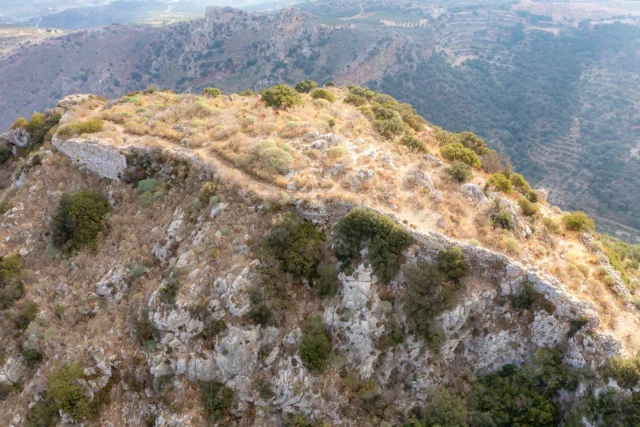A Village of Saints and Caves
Azogyres is a semi-mountainous village located in the southwestern part of Crete, within the municipality of Kantanos-Selino, Chania regional unit. It sits at an altitude of 360 meters and is situated approximately 73 kilometers southwest of Chania, near Paleochora. Historically part of the Selino province, Azogyres is known for its numerous caves with historical and religious significance, its association with prominent Cretan families, and the nearby Monastery of the Holy Fathers.
Origin of the Name
The name Azogyres is believed to be derived from the plant Anagyris foetida, which is found in the area and is known in Crete as “azogyros,” “azojeras,” “azogyres,” “azohiros,” etc.
Historical Overview
Ancient Era: The area of Azogyres is thought to have been the site of the ancient city of Achaea, possibly founded by Achaeans. Ruins are mainly visible at the location “Elliniko spiliari” (Greek cave) and on the hill “Tsounos.”
Byzantine and Venetian Eras: The inhabitants of Azogyres were initially Venetians, but they converted to Islam during the Arab occupation of Crete (824-961 AD) to retain their privileges. In the 14th century, monks from Egypt, Cyprus, and Antalya, led by the Cretan Saint John the Hermit (also known as Saint John the Stranger), came to the area and settled in the numerous caves around Azogyres. They preached Christianity to the local population, who had converted to Islam during the Arab period. The Monastery of the Holy Fathers was later founded in honor of these monks.
Prominent Families: Azogyres is considered the second homeland of the Kriaris family, a prominent Cretan clan that played a significant role in the island’s history. Other notable families with roots in Azogyres include the Polythodorakis, Polioudovardis, Kkoutsis, Antonovardis, and Papagiannakis families, who produced many warlords and leaders during their time. However, the village was also the birthplace of some hard-line Turco-Cretans, including the notorious leader of the Selino Janissaries, Kouris.
20th Century: The village was recognized as a distinct settlement in 1925 and was initially attached to the community of Paleochora. In 1997, it became part of the Pelekanos municipality, and in 2010, it was incorporated into the Kantanos-Selino municipality.
Population Data
Year |
Population |
|---|---|
1961 |
87 |
1971 |
53 |
1981 |
63 |
1991 |
52 |
2001 |
42 |
2011 |
35 |
2021 |
26 |
Points of Interest
Caves:
- Zoures Cave (Cave of the 99): A cave-pothole located west of the village. It has a maximum depth of 25 meters and a length of 95 meters. It is steep with stalactites but accessible via iron stairs. At the bottom of the cave, there is a source of drinking water and a chapel dedicated to the Holy Fathers, who, according to tradition, numbered 99 when they arrived in Crete.
- Harakas Cave: A cave where many bones were found, indicating it was a burial place for prominent individuals in the past. The bones are now kept at the Monastery of the Holy Fathers.
- Riza Caves: Two significant caves, one of which is carved (Pelekitos Spilios) and is about 25 meters high, accessible by carved steps. Inside, there is a room and a carved well, 10-15 meters deep.
Monastery of the Holy Fathers:
- Founded in 1864 in memory of the early ascetics who came to the area to preach Christianity. It was destroyed in 1866 but later rebuilt. The monastery houses relics, Turkish contracts, icons, Byzantine amulets, folklore exhibits, and photographic material. There is also a large, ancient plane tree on the monastery grounds.
Other:
- Spring of the Holy Fathers: Located at the eastern exit of the village.
- Church of Agios Georgios: Formerly decorated with frescoes.
- Cemetery Church of Agioi Theodoroi
Village Key Points
- Historical References: Possibly associated with the ancient city of Achaea. Known for its connection to Saint John the Hermit and the Kriaris family.
- Location: Chania regional unit, Crete, Greece. 73 km southwest of Chania town, near Paleochora.
- Altitude: 360 meters above sea level.
- Historical Significance: Historically significant for its caves, which were used by early Christian monks, and its association with prominent Cretan families.
- Current Status: A small, quiet village with a rich history and a focus on religious tourism.
References
Access
Azogyres is 5.8 kilometers away from Palaiochora and 6.5 kilometers away from Kandanos





















There are no comments yet.